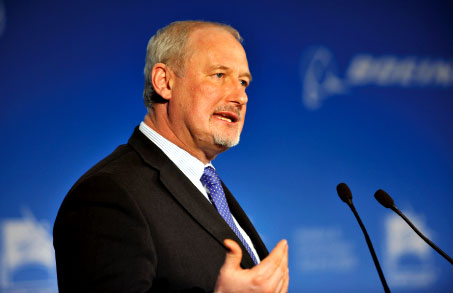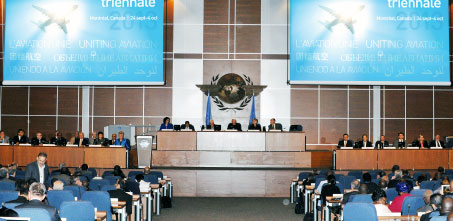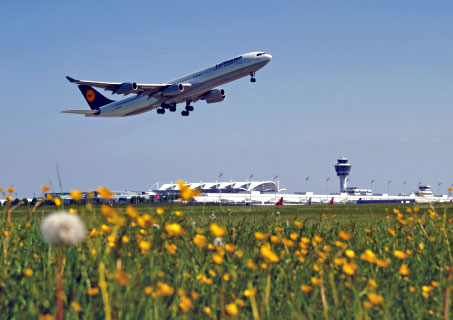
Paul Steele, ATAG Executive Director: “This is clearly an historic Resolution, showing the leadership of both developed and developing country governments meeting at ICAO in driving to the first comprehensive agreement on climate change for any global sector.”
The stakes were higher than ever at the 38th ICAO Assembly. The Kyoto Protocol – adopted in December 1997 and entered into force in February 2005 – had given ICAO responsibility for negotiating an international agreement to address aviation’s impact on climate change; most other sectors fall under the United Nations Framework Convention on Climate Change (UNFCCC). The Assembly was effectively the last chance to agree a deal; failure to do so would likely have resulted in aviation falling back under the auspices of the UNFCCC, who, significantly, are not aviation experts.

Close to 2,000 Ministers and other high-level officials joined ICAO at its HQ in Montréal this September/October for its 38th Triennial Assembly.
The aviation industry presented a united front, as it sought to ensure that the ICAO Assembly delivered. Grouped under the Air Transport Action Group (ATAG), industry stakeholders – including ACI, CANSO, IATA, the International Business Aviation Council (IBAC) and the International Coordinating Council of Aerospace Industries Associations (ICCAIA) – took the initiative of joining together behind a common climate change position, presenting a proposal for a global market-based measure (MBM). This reflected much publicised joint industry commitments for carbon neutral growth from 2020 and halving carbon emissions by 2050. ACI WORLD Director General Angela Gittens commented: “We were able to make clear that the industry was united in its objectives of making progress and lobbied ICAO and its Member States to encourage them to reach agreement. At one point during the very tense debates, an ATAG intervention calling on States to put aside their differences and to reach agreement drew spontaneous applause. The industry has helped States to see that if it can put aside its differences then so can, and should, governments.”
The results

Dr. Peter Schneckenleitner, Head of Political Communication, Lufthansa Group: “The ICAO Resolution to introduce a global market-based system for climate levies in aviation starting in 2020 shows that it is not only necessary, but also possible, to deal with environmental and economic issues concerning aviation in a sustainable manner.”
After two weeks of tense negotiations, which followed many years of discussions, ICAO Member States agreed a landmark Resolution that commits all governments to jointly develop a global market-based measure for aviation emissions from 2020, the modalities of which will be decided at the next ICAO Assembly, which is scheduled for 2016. This was an important outcome for the international civil aviation community and was adopted unanimously, giving strong credibility to the agreement. It demonstrated to the world that collectively the industry is serious about taking action to combat climate change. “This is clearly an historic Resolution, showing the leadership of both developed and developing country governments meeting at ICAO in driving to the first comprehensive agreement on climate change for any global sector,” said Paul Steele, ATAG Executive Director. “It represents significant progress. The aviation industry has been advocating such a scheme since we developed the first global industry targets five years ago. We now have agreement on a global scheme and a timeline and the building blocks to deliver it. Importantly, the Resolution also highlights the significance of continued work on the so-called ‘basket of measures’, recognising that a market-based measure is just one of a suite of important tools needed to reduce aviation emissions. New technology, more efficient operations and infrastructure improvements also need to be pursued – things the industry has been doing for many years.”
The ICAO Resolution set out a clear path towards 2020, from which point emissions attributable to aviation will not increase. In practical terms this means no matter how fast the industry grows, the emissions from current and new aircraft will be reduced through improved design, more efficient operations, better use of infrastructure, use of sustainable alternative fuels and by offsetting aviation emissions against reductions which can be made in other industries and projects more efficiently and effectively. ICAO spokesperson Anthony Philbin explained that the ICAO Council and Member States have been tasked with several requests in the Assembly Resolution, including to finalise technical, environmental and economic aspects of a global MBM, to consult with Member States and stakeholders through workshops and seminars and to address the special circumstances and respective capabilities of developing States in the design of a global scheme. A programme to address all of the environment-related tasks in the Resolution will be presented to the ICAO Council in March 2014.
Will Löfberg, Vice President International, Government and Environment Affairs, Emirates Airline, commented: “The adoption of a Resolution at the 38th Assembly committing to the development of a global market-based measure is a great accomplishment. The industry and regulatory bodies have worked hard to achieve this positive outcome, which sees aviation as being the first industry sector to have a multilateral global agreement to manage the growth of emissions.”
Meanwhile, Dr. Peter Schneckenleitner, Head of Political Communication, Lufthansa Group contended that fair global competition means dealing with global challenges such as climate change in collaboration with all nations participating in aviation. “The ICAO Resolution to introduce a global market-based system for climate levies in aviation starting in 2020 shows that it is not only necessary, but also possible, to deal with environmental and economic issues concerning aviation in a sustainable manner,” he said. “As a European airline, we want to see Europe playing an active role in the upcoming discussions and decisions, always considering not to disadvantage the competitiveness of EU airlines.”
What next for EU ETS?
The EU Emissions Trading Scheme (EU ETS), covering the full length of all routes to and from Europe, loomed large over the discussions. It was not endorsed by ICAO and will now need to be reviewed. During the ICAO Assembly proceedings, the European Commission proposed amending the EU ETS so that only that part of a flight that takes place in European airspace is covered by the scheme. The change would have applied from 1 January 2014 until a planned global market-based measure enters into force. This was rejected – most vociferously by the BRICS (Brazil, Russia, India, China, South Africa). In light of the ICAO Resolution, the European Commission, in coordination with the European Parliament and EU Member States, will now assess the way forward with regards to the EU ETS. It seems that the best way to maintain the momentum for the definition of the global MBM and advance with the new ICAO framework, would be to limit the scope of the EU ETS to intra-European routes.
Connie Hedegaard, EU Commissioner for Climate Action, said: “The EU’s hard work has paid off. After so many years of talks, ICAO has finally agreed to the first-ever global deal to curb aviation emissions. If it hadn’t been for the EU’s hard work and determination, we wouldn’t have got this decision to create a global market-based measure. What matters to us is that the aviation sector also contributes to our efforts to reduce emissions. While we would have liked more countries to accept our regional scheme, progress was made overall and we will now factor this in when, together with the Member States and the European Parliament, we decide on the way forward with the EU ETS.”
Steele added: “We must recognise the important role that the European Union has played in acting as a catalyst for discussions. The EU ETS, whilst it created tensions between States, also prompted action at a global level and their willingness to ‘stop the clock’ on extra-European flights, provided the necessary welcome relief of tension in the discussions.”
Conversely, the European Low Fares Airline Association (ELFAA) expressed disappointment at the outcome. John Hanlon, ELFAA Secretary General, commented: “While some interests have hailed the outcome as a landmark resolution, in that ICAO States have agreed to continue to study proposals for a global market-based mechanism to tackle aviation emissions, in reality, nothing of substance has been committed to, only three more years of discussions.” He also called for the EU to return to the all flights scope of the EU ETS, contending that an intra-EU ETS would be totally ineffective environmentally, capturing only a fraction of EU aviation carbon emissions.
The next three years will be spent on technical discussions as States work on the design elements of a global scheme. ACI will continue to support the process over the next three years to agree the necessary mechanics of this, including the all-important process of monitoring, reporting and verification of emissions: the so-called MRV. It will seek to impress on States the need for agreement to a comprehensive, single global scheme to be adopted at the next ICAO Assembly in 2016.







